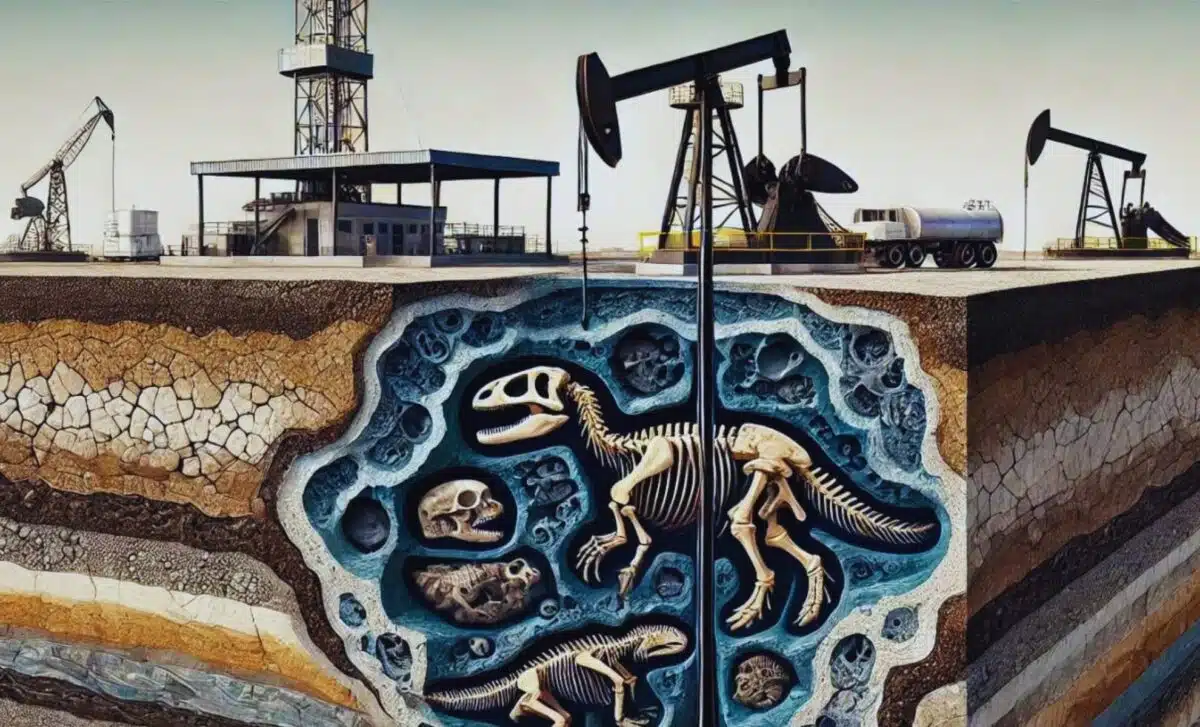Think oil comes from decomposed dinosaurs? Think again. The real story behind fossil fuels dives deeper. Find out the fascinating journey of how these tiny creatures created one of Earth’s most valuable resources.

Origins of Fossil Fuels: Why Dinosaurs Had Nothing to Do With It—And What Really Lies Beneath—© The Daily Galaxy—Great Discoveries Channel
The notion that oil originates from the decomposition of dinosaurs has intrigued and fueled imaginations for decades. This popular misconception, however, stray far from the scientific truth. While the fossil fuels we use today were formed millions of years ago, their origins lie in microscopic lifeforms rather than prehistoric giants.
The True Origins of Oil
Modern geology reveals that oil and natural gas are primarily the result of the decomposition of ancient microorganisms, particularly phytoplankton and algae. These tiny organisms accumulated in sedimentary layers over millions of years, undergoing immense pressure and heat deep within Earth’s crust.
This process of transforming organic matter into hydrocarbons—molecules rich in carbon and hydrogen, which are the building blocks of petroleum itself—involves a number of different stages that take place over millions of years:
- Accumulation of organic material: Microorganisms settle at the bottom of ancient seas or lakes.
- Sedimentation: Layers of sediment bury the organic matter, preventing decomposition by oxygen.
- Transformation: Heat and pressure convert this organic material into kerogen and eventually hydrocarbons under specific geological conditions.
- Migration and trapping: The oil and gas migrate through porous rock layers and get trapped beneath non-porous rock, forming reservoirs.
Contrary to popular belief, the study of biomarkers, molecular remnants of ancient life, demonstrates that the vast majority of oil derives from marine microorganisms rather than large terrestrial creatures like dinosaurs. This conclusion is supported by the environments where oil deposits are found, which were once shallow seas or deltas teeming with microbial life.
The Age of Oil and Dinosaurs: A Timeline Mismatch
The geological timelines add another layer of evidence against the dinosaur-oil myth. While most dinosaur species roamed the Earth between 230 and 66 million years ago, the organic material responsible for many oil reserves predates their existence.
Some deposits date back over 500 million years, to a time when life was primarily aquatic and microscopic. The formation of oil requires very specific geological conditions that align with key features of Earth’s history:
- Age range: From as recent as 15 million years ago to over 1 billion years.
- Source rocks: often marine shales rich in organic carbon.
- Reservoir conditions: Temperatures between 60 °C and 120 °C (commonly referred to as the “oil window”).
Even the oil formed during the Jurassic and Cretaceous periods, when dinosaurs thrived, is overwhelmingly derived from algae and plankton rather than animal remains. This reality underscores the critical role of Earth’s oceans in shaping its hydrocarbon reserves.
Why not dinosaurs?
Though the idea of fossil fuels containing bits of T-Rex or Diplodocus might be compelling, it overlooks an essential fact: dinosaurs represented a tiny fraction of Earth’s total biomass. Today, animals—including humans, mammals, and reptiles—account for less than 0.5% of Earth’s organic carbon. By comparison, microorganisms and plants dominate, making them the primary contributors to organic deposits.
Moreover, the conditions for fossil fuel formation favor environments rich in smaller organisms that rapidly accumulate and decompose in sedimentary layers. Dinosaur carcasses, though massive, were far less numerous and distributed, making them an unlikely source for significant oil reserves.